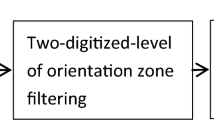Abstract
Orientation pattern is an important feature for characterizing fingerprint and plays a very important role in the automatic fingerprint identification system (AFIS). Conventional gradient based methods are popular but very sensitive to noise. In this paper, we present an improved fingerprint orientation field (FOF) extraction method based on quality grading scheme. In order to effectively remove the noise, the point orientations are fitted by using 2D discrete orthogonal polynomial. The role of the gradient modulus is taken into full account, and the weights of the point orientations are obtained by computing the similarity of the fitted point orientations. The block qualities are assessed by the coherence of point orientations and the block orientations are estimated based on quality grading scheme. In the proposed method, it does not need any prior knowledge of singular points. To validate the performance, the proposed method has been applied to fingerprint singularity detection and fingerprint recognition. We compared the proposed method with other state-of-the-art fingerprint orientation estimation algorithms. Our statistical experiments show that the proposed method can significantly improve in both singular point detection and matching rates, and it is more robust against noise.












Similar content being viewed by others
References
Wen X, Shao L, Xue Y et al (2015) A rapid learning algorithm for vehicle classification. Inf Sci 295(1):395–406
Xia Z, Wang X, Zhang L et al (2016) A privacy-preserving and copy-deterrence content-based image retrieval scheme in cloud computing. IEEE Trans Inf Forensics Security. doi:10.1109/TIFS.2016.2590944
Zhou Z, Wang Y, Jonathan Q et al (2016) Effective and efficient global context verification for image copy detection. IEEE Trans Inf Forensics Security. doi:10.1109/TIFS.2016.2601065
Wei X, Wang H, Guo G et al (2015) Multiplex image representation for enhanced recognition. Int J Mach Learn Cyber. doi:10.1007/s13042-015-0427-5
Maltoni D, Maio D, Jain A, et al. (2009) Handbook of fingerprint recognition, 2nd edn. Springer-Verlag, London, UK
Gottschlich C (2012) Curved-region-based ridge frequency estimation and curved gabor filters for fingerprint image enhancement. IEEE Trans Image Process 21(4):2220–2227
Sutthiwichaiporn P, Areekul V (2013) Adaptive boosted spectral filtering for progressive fingerprint enhancement. Pattern Recogn 46(9):2465–2486
Karu K, Jain A (1996) Fingerprint classification. Pattern Recognit 29(3):389–404
Bazen A, Gerez S (2002) Systematic methods for the computation of the directional fields and singular points of fingerprints. IEEE Trans Pattern Anal Mach Intell 24(7):905–919
Zhou J, Chen F, Gu J (2009) A novel algorithm for detecting singular points from fingerprint images. IEEE Trans Pattern Anal Mach Intell 31(7):1239–1250
Liu M (2010) Fingerprint classification based on Adaboost learning from singularity features. Pattern Recognit 43(3):1062–1070
He Y, Tian J, Li L et al (2006) Fingerprint matching based on global comprehensive similarity. IEEE Trans Pattern Anal Mach Intell 28(6):169–177
Feng J (2008) Combining minutiae descriptors for fingerprint matching. Pattern Recognit 41(1):342–352
Cao K, Yang X, Chen X (2012) A novel ant colony optimization algorithm for large-distorted fingerprint matching. Pattern Recognit 45(1):151–161
Kass M, Witkin A (1987) Analyzing oriented patterns. Comput Vis Graph Image Process 37(3):362–385
Rao A, Jain R (1992) Computerized flow field analysis: oriented texture fields. IEEE Trans Pattern Anal Machine Intell 14(7):693–709
Jiang X (2005) On orientation and anisotropy estimation for online fingerprint authentication. IEEE Trans Signal Process 53(10):4038–4049
Wang Y, Hu J, Han F (2007) Enhanced gradient-based algorithm for the estimation of fingerprint orientation fields. Appl Math Comput 185(2):823–833
Jiang X (2007) Extracting image orientation feature by using integration operator. Pattern Recognit 40(2):705–717
Mei Y, Cao G, Sun H et al (2012) A systematic gradient-based method for the computation of fingerprint’s orientation field. Comput Electr Eng 38:1035–1046
Sherlock B, Monro D (1993) A model for interpreting fingerprint topology. Pattern Recognit 26:1047–1055
Li J, Yau W, Wang H (2006) Constrained nonlinear models of fingerprint orientations with prediction. Pattern Recognit 39(1):102–114
Ram S, Bischof H, Brichbauer J (2010) Modelling fingerprint ridge orientation using Legendre polynomials. Pattern Recognit 43(1):342–357
Jirachaweng S, Hou Z, Yau W et al (2011) Residual orientation modeling for fingerprint enhancement and singular point detection. Pattern Recognit 44(2):431–442
Bian W, Luo Y, Xu D et al (2014) Fingerprint ridge orientation field estimation using the best quadratic approximation by orthogonal polynomials in two discrete variables. Pattern Recognit 47(10):3304–3313
Perona P (1998) Orientation diffusions. IEEE Trans Image Process 7(3):457–467
Liu M, Liu S, Zhao Q (2014) Fingerprint orientation field estimation by weighted discrete cosine transform. Inf Sci 268:65–77
Karu K, Jain AK (1996) Fingerprint classification. Pattern Recognit 29(3):389–404
Tico M, Kuosmanen P (2003) Fingerprint matching using an orientation-based minutia descriptor. IEEE Trans Pattern Anal Machine Intell 25(8):1009–1014
Acknowledgements
The work is partially supported by the National Natural Science Foundation of China under Grant No. 61672522, Anhui Provincial Natural Science Foundation under Grant No. 1708085MF145, the Priority Academic Program Development of Jiangsu Higer Education Institutions (PAPD), and the Jiangsu Collaborative Innovation Center on Atmospheric Environment and Equipment Technology(CICAEET).
Author information
Authors and Affiliations
Corresponding author
Rights and permissions
About this article
Cite this article
Bian, W., Ding, S. & Xue, Y. An improved fingerprint orientation field extraction method based on quality grading scheme. Int. J. Mach. Learn. & Cyber. 9, 1249–1260 (2018). https://doi.org/10.1007/s13042-016-0627-7
Received:
Accepted:
Published:
Issue Date:
DOI: https://doi.org/10.1007/s13042-016-0627-7




